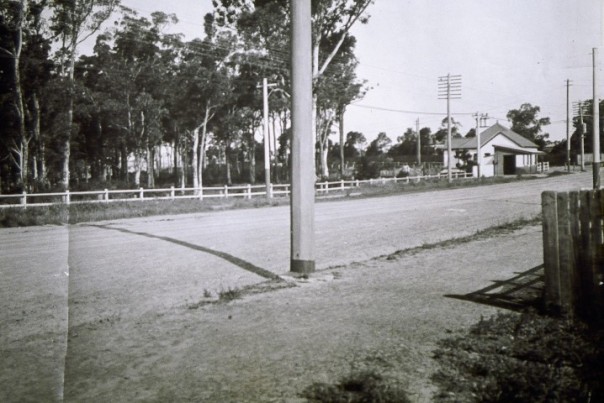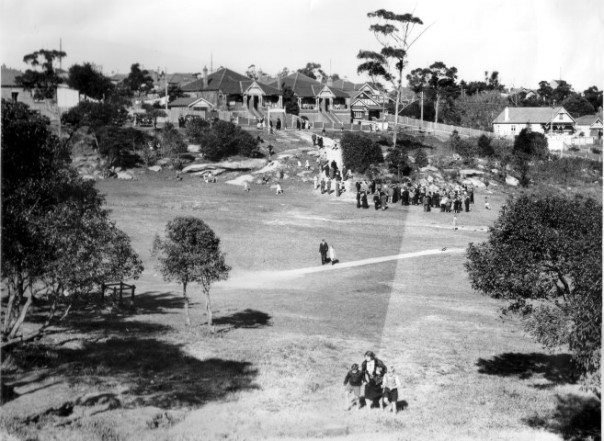Category Archives: Abbotsford
Henry Lawson in the Park
City of Canada Bay will be marking the 150th anniversary of the birth of Henry Lawson with a performance of some of his best known works in Henry Lawson Park on 17 June 2017.
Henry Lawson Park at Abbotsford was officially dedicated on 3 September 1938 by Alderman Jacob Henley, Mayor of Drummoyne (on the left), Honourable William McCall, Federal Member for Martin and Alderman Thomas Higham. To mark the occasion, three trees were planted near the foreshore by Eileen M. Buckley of the Henry Lawson Literary Society, Bertha Lawson, his wife and Mary Gilmore, his friend and fellow poet. The tree planted by Mary Gilmore had a plaque with an original verse by her:
‘As weeds grow out of graves and vaults
So from his broken heart his faults
And yet so marvellous his power
His very faults brought forth in flower.’
Henry Lawson remembered
This year marks the 150th anniversary of the birth of Henry Lawson who captured the spirit of Australia through his short stories and poems.
An exhibition to mark the occasion at Five Dock Library highlights his association with the City of Canada Bay. Born in Grenfell on the 17 June 1867, he spent the last period of his life at Abbotsford, where he died on the 2 September 1922. He was also one of the more famous patients at Thomas Walker Convalescent Hospital at Concord which he described as ‘a stately home of Rest’ in his poem The Unknown Patient.
Today he is remembered by Henry Lawson Park at Abbotsford and a memorial and hall named in his honour at Abbotsford Public School.
There will also be talk about Henry Lawson’s life and work by Susannah Fullerton at Five Dock Library on Tuesday, 2 May at 6pm for 6.30pm start. More events are planned by the City of Canada Bay in June in Henry Lawson Park.
Above is a sketch of Lawson’s cottage at Abbotsford by John Barclay Godson (read more under comments).
One hundred years of shelter
While the Great North Road at Abbotsford has changed markedly since this photograph was taken in 1918, the tram shelter (seen on the right) has remained a constant fixture for over a hundred years.
According to the Sydney Tramway Museum these shelters were called ‘Waiting Rooms’ or ‘Waiting Sheds’. The one at Abbotsford was erected on 21 July 1911.
The Abbotsford line opened as a steam tramway and was the last of the western suburbs tramways to be electrified. The fully electrified tramway opened on Sunday, 16 April 1905. The first electric tram to Abbotsford was N class car 647 which completed a trial trip a few days before the opening. Services were provided by the Rozelle Tram Depot and an improved service, running every twenty minutes, replaced the steam service.
Now serving as a bus shelter, it has recently been fully restored, ensuring it will continue to provide shelter for many years to come.
Along the Great North Road
An exhibition at Five Dock Library highlights the changes along the Great North Road over more than a century.
The Great North Road was built using convict labour between 1826 and 1836 and extended 240 kilometres north from Sydney to the Hunter Valley. For its time, the road was a significant engineering achievement and today a section has World Heritage listing.
The Five Dock to Abbotsford section of the road is the only section still retaining the original name, ’Great North Road’.
The land either side of the Great North Road was originally all part of one large land grant to Surgeon John Harris in 1792 and known as Five Dock Farm. In 1837 the land was subdivided into smaller lots by auctioneer Samuel Lyons. The area remained largely semi-rural until the introduction of a tram service in the 1890s promoted further subdivision of the area for housing.
The photograph shows a tram near the Abbotsford terminus in the 1890s. One imagines the well-dressed crowd may well have been spectators at one of the many rowing contests along the Parramatta River in that period.
The display continues at Five Dock Library until the end of 17 October 2016. There’s an album of the images on the library’s flickr page.
Discover your local area
‘Discovery and Rediscovery’ is the theme of this year’s National Trust Heritage Festival, 16 April-29 May 2016.
Local Studies will be conducting two walking tours ‘Discover Cabarita and Breakfast Point’ and ‘Discover Abbotsford’ which can be booked online. For those wanting to explore Rhodes at their own time and pace, a free Rhodes walking tour app has recently been released by the City of Canada Bay which is available through the App Store or Google Play.
There will also be a talk on Spectacle Island, which is probably the least known of Sydney Harbour’s islands, at Five Dock Library on 19 May 2016. City of Canada Bay Museum has an interesting display ‘Discover Drummoyne’ and there will be an open day at Yaralla on Sunday, 24 April 2016.
The photograph, above, was taken at the dedication of Henry Lawson Park, Abbotsford on 3 September 1938.
Abbotsford Baths
In the early part of the twentieth century there were many swimming pools dotted along the Parramatta River, providing recreation for the community.
The Abbotsford Swimming Baths opened in early 1908 and were described as ‘most up-to-date swimming baths’. An unusual feature of the baths was a 12 metre high diving platform.
The baths quickly became a popular venue for swimming carnivals. The Abbotsford Amateur Swimming Club was formed in December 1907, just prior to the opening of the baths, while other early swimming clubs using the facilities were the Five Dock and District Club and the Western Ladies’ Club.
By the early 1950s Abbotsford Swimming Baths had closed and the Abbotsford 12 foot Flying Squadron clubhouse was built on the site in 1954.
Animal Quarantine Station
When Bradley’s Head was chosen as the site of Taronga Zoo, Sydney’s quarantine station for imported animals needed a new home. In 1916, the Commonwealth Government bought a 2.38 hectare site on the Abbotsford Peninsula and officially gazetted it as a quarantine station four years later. The site was originally part of the Hexham Estate, which included a grand house and extensive grounds that swept down to Hen and Chicken Bay.
The Animal Quarantine Station provided accomodation for imported cattle, horses, pigs and dogs. Many valuable racehorses were quarantined there and sometimes more exotic animals. Legend has it that a giraffe is buried on the grounds.
During World War II, the station was closed due to restrictions on livestock importation and the site was used as a military store. After the war ended the quarantine station resumed its original function, much to the dismay of local residents who strongly opposed its reopening. A campaign was started to move the quarantine station out of the area because of its offensive odours, noise from animals, smoke and pollution from the incinerator. However, it was many years before the objections of residents prevailed and the station was moved to Wallgrove in 1980.
In 1981 the site was transferred from Commonwealth ownership to the State Government. Drummoyne Council then landscaped the area for public parkland and it is now known as Quarantine Reserve.
Abbotsford House
Abbotsford House was built in 1877-78 for Sir Arthur Renwick (1837-1908) at a cost of £11,000. Renwick was born in Scotland and emigrated to Australia with his parents in 1841. He was a medical practitioner and businessman who served as a member of the NSW Parliament and was the first President of the NSW Medical Board.
The house was named after Abbotsford in Scotland, the home of author Sir Walter Scott. In turn Abbotsford House gave the suburb of Abbotsford its name. Montrose, Rokeby and Marmion Roads in Abbotsford are named after works by Sir Walter Scott.
In 1904 Renwick suffered heavy financial losses and he was forced to sell his property, which was subdivided and sold by auction in 1905. Peter McIntosh purchased the property in 1906 and sold it the following year to Albert Edward Grace, one of the founders of Grace Bros. In 1917 the property was sold to Nestlé.
The photograph shows Abbotsford House in 1917 when building of the Nestlé factory had just commenced.
The chocolate factory
Nestlé, then known as the Anglo-Swiss Condensed Milk Company, purchased Abbotsford House and its grounds in 1917 to build the ‘largest chocolate factory in the Southern Hemisphere’. Abbotsford House was retained for use as offices, while the factory was constructed on three sides of the house. Nestlé commenced production in 1918.
It was regarded as a model factory with excellent staff amenities. Over the next seventy years Nestlé was a major employer in the area and it was not unusual for several generations of the same family to work for the company.
In 1927 the grounds and foreshore of the Nestlé site were used in the filming of For the Term of His Natural Life. During World War II the factory packed supply rations for soldiers on the Kokoda Track.
Following the closure of the factory on 18 December 1991 the site was redeveloped for medium density housing. Abbotsford House was preserved and once again became a private home.
In the photograph, the word Nestlé’s is spelt out by the factory workers standing in formation.









